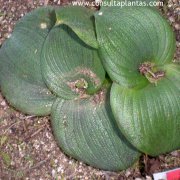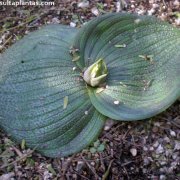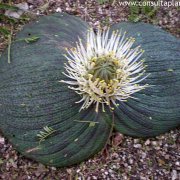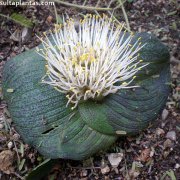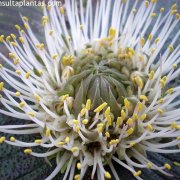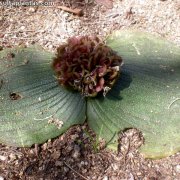Care of the bulbous plant Massonia pustulata or Blistered massonia |
|
The genus Massonia, family Asparagaceae, comprises 12 species of bulbous plants native to South Africa. Some species are: Massonia pustulata, Massonia etesionamibensis, Massonia pygmaea, Massonia jasminiflora. Common name: Blistered massonia. This species is native to the Western Cape of South Africa. They are curious bulbous plants with a prostrate bearing. They have 2 opposite leaves, 20 cm (7.87") long, round in shape, dark green in color with marked veins on the upper surface and covered with small pustules. The flowers appear in the center of the plant and are white or cream in color. They bloom in winter. Due to their small size Blistered massonia is used in pots but they are also suitable for rockeries. Massonia pustulata can be grown in full sun and semi-shade exposures. It needs a warm climate but it resists frosts down to -8 ºC (17.6 ºF). The soil must be very well drained and contain organic matter; Blistered massonia does not resist calcareous soils. The transplant is done in autumn. Water regularly with lime-free water during autumn and winter so that the substrate does not dry out completely but never floods; If it grows in a pot, it's advisable to water it by immersion to wet the leaves as little as possible. Do not water in summer because the plant goes to rest. Water from autumn when the plant begins to grow. Massonia pustulata does not need fertilizers or pruning. The leaves can be eaten by snails and slugs; Blistered massonia can be attacked by fungi if there is excess watering. Massonia pustulata propagates from seeds sown in autumn; They can be obtained from the small pods that the plant produces. |
Images of the bulbous plant Massonia pustulata or Blistered massonia |
Find plants
Massonia pustulata or Blistered massonia | Care and Growing
© 2025 FavThemes
